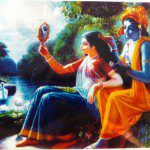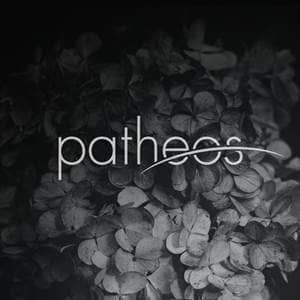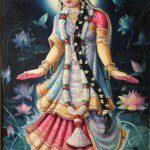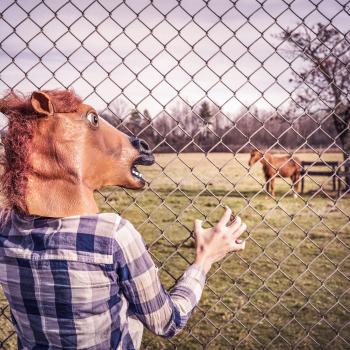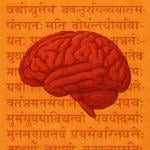Vishnu (Vish-nuu or Wish-nuu) is another member of the Hindu trinity. It is Vishnu who represents preservation. He maintains the world and so he is very popular for woship. A branch of Hinduism views Vishnu as the ultimate Lord of all. That branch is called Vaishnava. Many people who follow Vishnu in particular are highly devotional, hence the people that you’ll encounter who lose themselves in singing Hare Krishna; Hare Rama! Those are manifestations of Vishnu, the God who comes to earth and takes physical bodies to help the world. Because of his avatars (human forms) he is someone that you can really personally relate to more than a distant view of God.
Why Worship Vishnu* Stories * Symbolism * Holidays * How He Is Worshiped * Mantras and Bhajans
Why Worship Vishnu
Vishnu is the preserver and cares for life on earth. Worshiping him and his wife Lakshmi helps with protection, prosperity, knowledge, and a satisfying life. You can worship Vishnu as himself or any of his avatars. (See this post on the free blog for more info on the ten avatars of Vishnu)
Stories
It is said that Shiva and Brahma will give boons to anyone who demonstrates devotion, perhaps unable to distinguish between good and evil beings. Vishnu, on the other hand, protects mankind and the Gods from demons given too much power by praying to the other two!
Heaven, earth, and air are said to be three steps of Vishnu.
Most of the stories about him are stories of what he did as an avatar. The Ramayana and The Bhagavad Gita are stories of him. Because of this, more stories can be found at the ten avatars of Vishnu post.
Symbolism
More on the symbolism here: http://www.stephen-knapp.com/lord_vishnu.htm
Holidays
The biggest Vishnu holiday is Krishna Janmashtami, which is Krishna’s birthday. It usually happens in late August. Find information on how to celebrate here at the other blog.
How He Is Worshipped
There are different pujas that can be directed to Vishnu in various of his forms. Bare in mind that Krishna says in the Gita that he accepts any offering given in devotion to him, whether it be a leaf, a flower, or a single drop of water. He cares more about the intention of a prayer than getting it “right.”
Sudarshan Prayog
This ritual is said to provide invisible protection against enemies or evil.
- Initiate the ritual on a Friday night after 11:00 pm. Start by bathing and dressing in clean, fresh, white clothes.
- Cover a wooden bench or seat with a white cloth. Place a small mound of uncooked white rice on the cloth. On the mound of rice place a Sudrashan Yantra

- Place a white mat down in front of the bench and sit on it facing east.
- Look at the Yantra and visualize yourself in the center of the pattern, protected from all evil. Chant “Om Namo Narayanaya Namah.” (“I bow to the name of Narayana”)
- To the right of the Yantra place a Sudarshan Tarang Gutika (a small ball of protection) This instruction is repeated multiple places, yet I see no record of what it is. My best guess is that it is this image:
- Offer vermilion, white flowers, rice grains, incense, and a ghee lamp in front of the yantra.
- Chant eleven rounds of “Aum Sudarshan Chakraay Mam Sarv Kaarya Vijayam Dehi Dehi Aum Hum Phat.” (Using a mala rosary is recommended.)
Instructions then say to repeat this process every day for eleven days and to remain celibate during that time.
Vishnu Vrats
These are fasts and there are different ones for different months. Here is one to be preformed on the full moon of the “ninth month” (Poush). You’d have to check each year when that is, since the western and eastern calenders run differently (It’s around December or January). It is said that it will fulfill all wishes…
- Begin the first day of Vishnu Vrat by bathing with mustard seed and water. Worship Krishna’s feet with the mantra, “Om Shri Krishnaya namah.”
- Bathe on the second day with black sesame seed mixed water. Worship Krishna’s navel with “Achyuta Namah” Mantra (Om Achyuta namah), chanted to Shri Achyuta, a form of Shri Vishnu.
- Bathe with Bach herb and water on the third day. Worship Krishna’s eyes and chant, “Om Anantaay namah.”
- Bathe with the herbs, Kapoor Kacharee, Bach, Kooth, Shilaajit, whole Haldee, Daaru Haldee, Kachoor, Champaa, Mothaa and water on the final day of Vishnu Vrat. Perform devotion to Krishna’s forehead with “Om Hrishikesha namah” mantra offering fragrant flowers.
From: http://www.ehow.com/how_2343589_perform-vaishnava-worship.html#ixzz2gOOLLy4F
Thursday
While Monday is the day special to Shiva, Thursday is the day for Vishnu. On this day people may fast (or consume only one meal of only yellow food), wear yellow, and offer yellow flowers to the deity.
Note: Vaishnavas are more likely to believe in dualism and that God is a great being above us to be worshiped and adored, unlike in some other Hindu sects that believe in non-dualism and that God and humans are the same.
Mantras & Bhajans
The main mantras are ” OM VISHNAVE NAMAH ” or ” OM NAMO NARA-YANAY”
The Hare Krishna mantra is a form of Vishnu worship (called Maha Mantra by devotees). It goes:
Hare Krishna, Hare Krishna
Krishna, Krishna, Hare, Hare
Hare Rama, Hare Rama,
Rama, Rama, Hare, Hare
You repeat that 108 times (often using a “rosary” of mala beads). “Hare” is pronounced “Haar-eh”
http://www.youtube.com/watch?v=yZNSbznWmMY(To find more, look up the following words on YouTube: Krishna, Govinda, Narayan, Vishnu)







